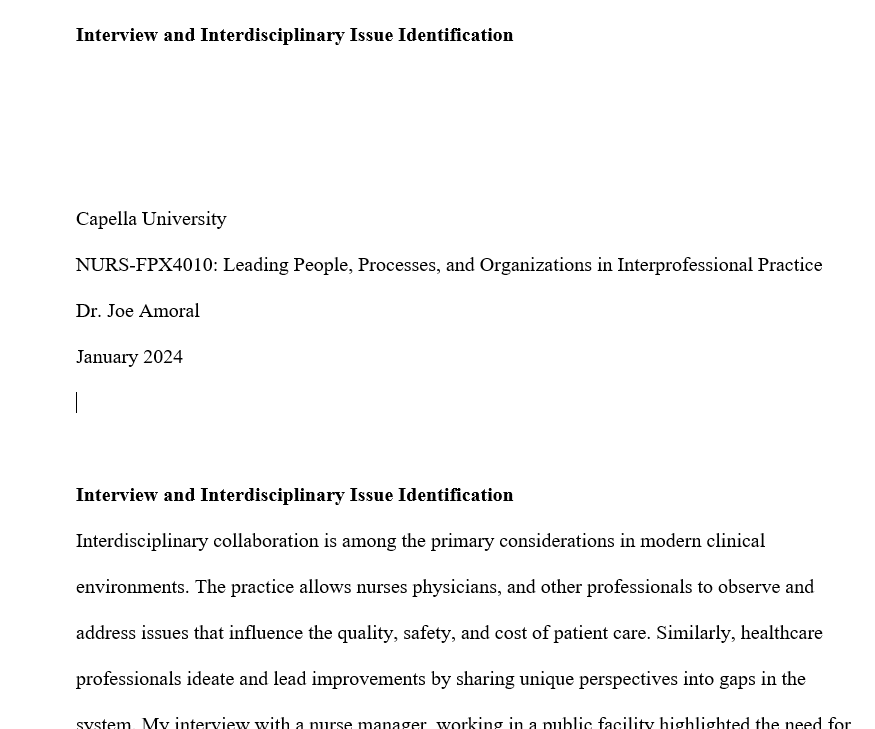NURS-FPX4010_S_Assessment 2-1 solution.docx
Interview and Interdisciplinary Issue Identification
Capella University
NURS-FPX4010: Leading People, Processes, and Organizations in Interprofessional Practice
Dr. Joe Amoral
January 2024
Interview and Interdisciplinary Issue Identification
Interdisciplinary collaboration is among the primary considerations in modern clinical environments. The practice allows nurses physicians, and other professionals to observe and address issues that influence the quality, safety, and cost of patient care. Similarly, healthcare professionals ideate and lead improvements by sharing unique perspectives into gaps in the system.
My interview with a nurse manager, working in a public facility highlighted the need for well-coordinated and collaborative clinical practices. Serving in senior leadership position enables the interviewee to monitor and interpret events within the clinical environment.
The manager receives feedback from members of the care team on events within the medical-surgical unit and their implications on strategic priorities. I developed a qualitative interview to acquire in-depth information on scenarios that shaped the quality, safety, and cost of care. The interviewee identified issues such as staff turnover, hospital-acquired infections, resistance to changes, and errors caused by the demanding nature of medical-surgical activities.
The Issue
The nurse manager identified hospital-acquired infections as one of the persistent challenges in the facility. Surgical site infection is a growing concern that reminds the interviewee and the workforce to initiate evidence-based and sustainable solutions. The issue reveals administrative, technical, and human-related failures that may cause increased morbidity and mortality risks.
Preventing hospital-acquired infections improves quality and safety of services in the medical-surgical unit. The facility also reduces cost of care due to reduced lawsuits, reduced risk of prolonged hospitalization, and few readmission rates. The issue highlights the need for collaborative efforts to identify risk factors and share unique perspectives into the best strategies for intercepting undesirable scenarios.
Change Theory Relevant for Addressing the Issue
Preventing hospital-acquired infections requires health leaders to initiate change plans with details of collaborative values, behaviors, and attitudes to achieve the intended results. The Plan-Do-Study-Act (PDSA) framework is among the preferred models based on its practicality and ability to facilitate incremental improvements.
The concept guides leaders to design and implement action steps and ideas associated with monitoring and intercepting HAIs. McNicholas et al. (2019) recognized PDSA as a model that supports systematic approaches for planning, resting initial results, observing outcomes, and using the output to scale strategies for preventing surgical site infections.
Leadership Strategies to Address Surgical Site Infections
Competent leadership influences the workforce commitment to helping the organization monitor and intercept risks across the continuum. The transformational leader is the right option for a facility aiming to reduce surgical site infections.
The leader acknowledges team-based functions, values, and behaviors. The transformational approach also allows a leader to create an open, transparent, and honest environment where nurses, physicians, and other professionals share insights into the best practices for enhancing quality and safety of patient care.
Further, the leader embraces effective communication and shared governance to enable them initiate and sustain interdisciplinary practices. As such, it is easier for the organization to adopt interventions such as interdisciplinary safety rounds to identify risks factors associated with surgical site infections and intercept them on time.
The care team acknowledges the need for individual and collective responsibility and obligation towards sharing information on gaps in the system and evidence-based strategies for improving outcomes.
Interdisciplinary Collaboration to Prevent Surgical Site Infections
The team includes nurses, physicians, clinical assistants, operating room supervisor, nurse manager, and an administrator. The group has frontline experiences at the bedside and organizational levels, which enable them to make informed decisions on sustainable solutions for preventing HAIs.
The leader encourages everyone to share opinions on the interdisciplinary safety rounds and their relevance in enabling the team to identify and address risks. Briefings, training and education are necessary to make everyone aware of the prevailing situation and their roles in addressing gaps that undermine the quality and safety of patient care.
References
McNicholas, C., Lennox, L., Woodcock, T., Bell, D., & Reed, J. E. (2019). Evolving quality improvement support strategies to improve plan–do–study–act cycle fidelity: A retrospective mixed-methods study. BMJ Quality & Safety, 28(5), 356–365. https://pubmed.ncbi.nlm.nih.gov/30886118/
Sartelli, M., Pagani, L., Iannazzo, S. et al. (2020). A proposal for a comprehensive approach to infections across the surgical pathway. World Journal of Emergency Surgery, 15(13), 1-24. https://doi.org/10.1186/s13017-020-00295-3
Schot, E., Tummers, L., & Noordegraaf, M. (2020). Working on working together: A systematic review on how healthcare professionals contribute to interprofessional collaboration. Journal of Interprofessional Care, 34(3), 332-342. https://pubmed.ncbi.nlm.nih.gov/31329469/
Varagona, L., Nandan, M., Hooks, D., Porter, K. J., Maguire, M. B., Slater-Moody, J. (2017). A model to guide the evolution of a multi-professional group into an interprofessional team. The Journal of Faculty Development, 31(2), 49-56. https://eric.ed.gov/?id=EJ1142348
Weiser, M.R., Gonen, M., Usiak, S., Pottinger, T., Samedy, P., Seo, S., Smith, J., Temple, L., Nash, G.M., Paty, P., Cheavers, C.E., Eagan, J., & Garcia-Aguilar, J. (2018). Effectiveness of a multidisciplinary patient care bundle for reducing surgical-site infections. British Journal of Surgery, 105, 1680-1687. https://www.ncbi.nlm.nih.gov/pmc/articles/PMC6190910/



